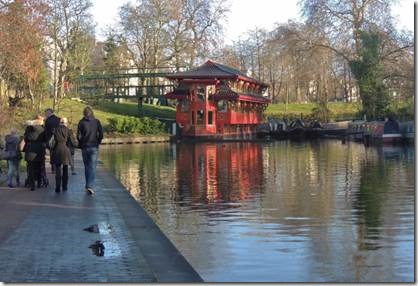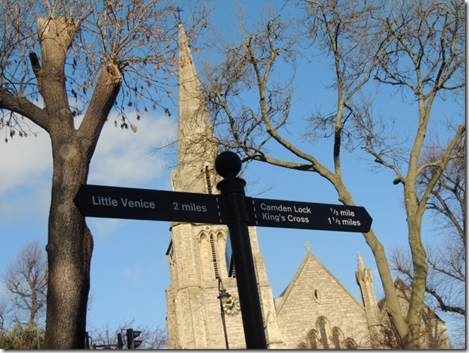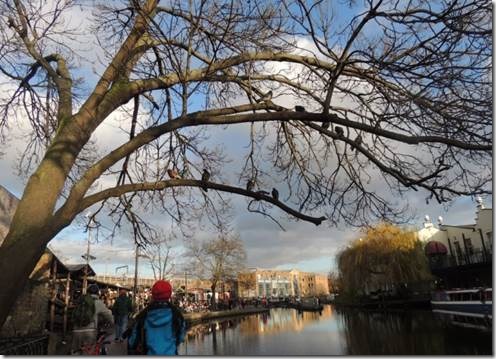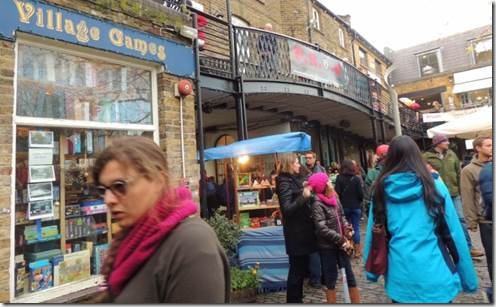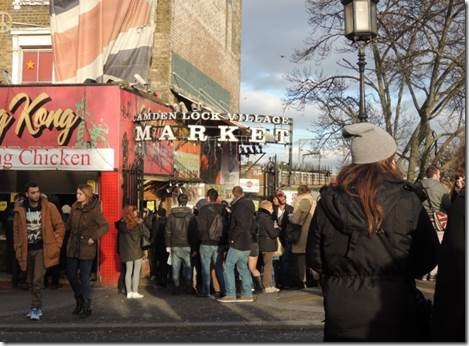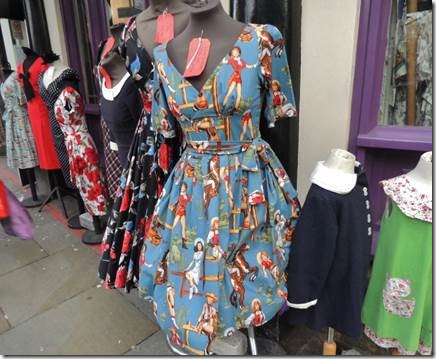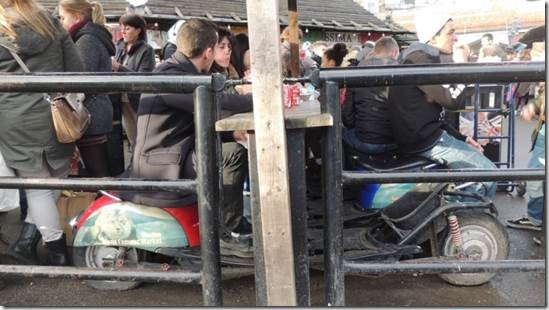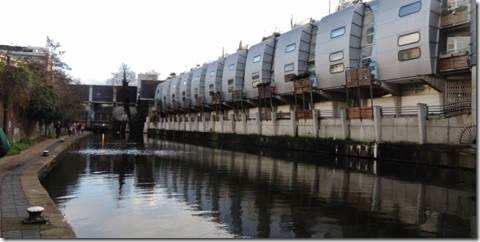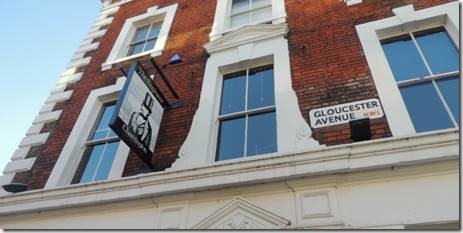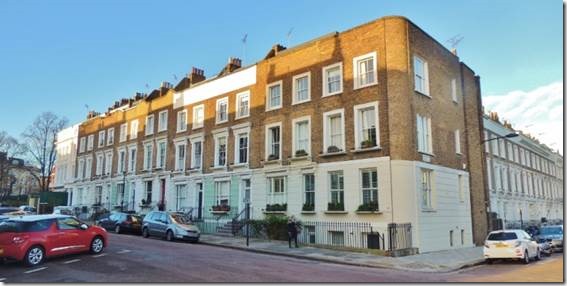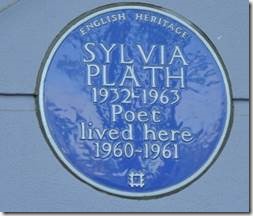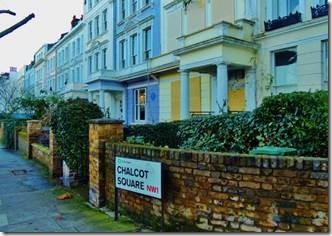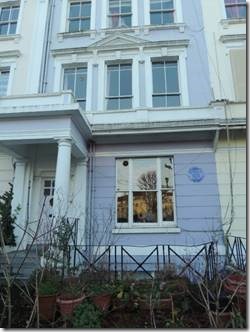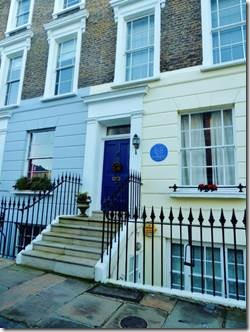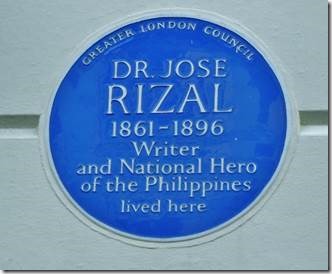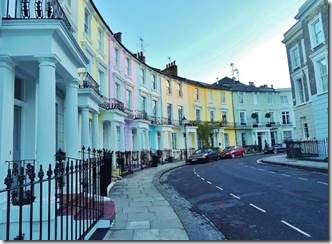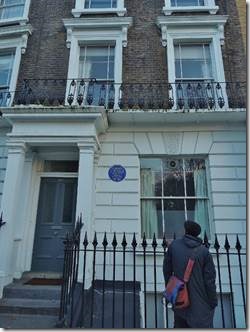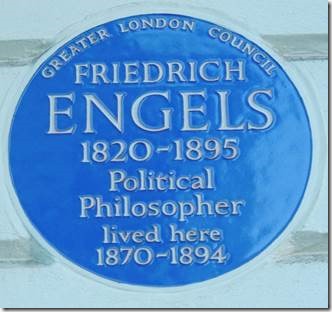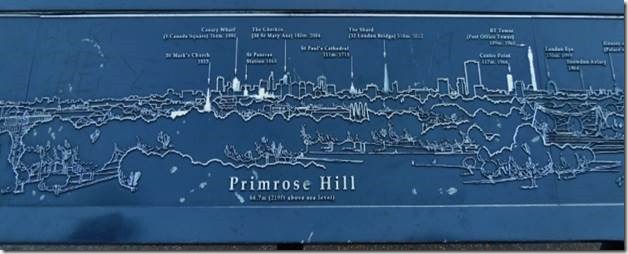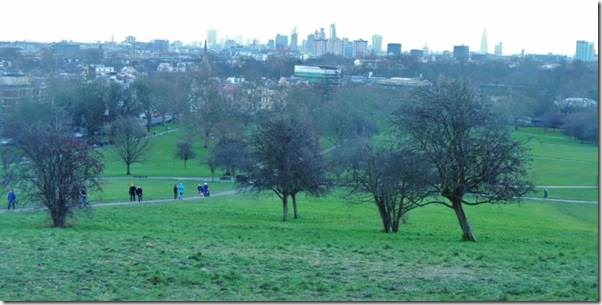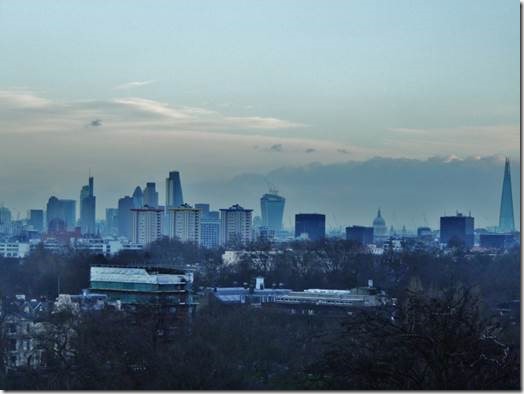Cheers,
This email concludes our Little Venice through Camden walk. According to the Canal Trust website where I found the directions for the walk, completed it was 4.5 miles. We missed the final few stops but must have walked more than 4 miles just the part we did. At least it felt that way. But it was lots of fun and good exercise. Just wish we’d brought some snacks!
Ru
|
6. Camden Lock Ahead you will see the Feng Shang Chinese floating restaurant moored in Cumberland Basin. This arm of the canal used to stretch towards Euston station but was largely filled in with bomb rubble after the Second World War. At this point, the canal takes a sharp turn to the left towards Camden. From Cumberland Basin, Camden Lock is approximately five or ten minutes’ walk along the towpath, should you wish to make a detour. Camden is best known for its alternative and vibrant market scene, which centres on a cobbled courtyard just off the canal. Camden Lock Market is particularly lively at weekends and is a great place to break from the walk for shopping and refreshments. |
|
It felt like more than two miles since we’d left Little Venice |
|
Camden Town |
|
“In recent years, Camden has ditched its grubby image to become one of the capital’s most fashionable addresses. The moment you step outside the tube station, Camden attacks the senses. Bass thumps from the market stalls’ speakers, the scent of street food and incense permeates the air, and goths, punks, pushers and tourists shove past, giving the area an unorthodox charm. Come to Camden for the atmosphere, but stay for the cheap restaurants and awesome live music scene” http://www.timeout.com/london/things-to-do/camden-area-guide |
|
On the right person I think this would look great. |
|
Mini motorbikes as seating for eating the tons of available street food. Really more crowded than we like so, after lunch at a “sit down place” we continued our journey |
|
Looks like mobile homes or RVs backed up to the canal, but they’re apartments. Probably expensive apartments. We retraced our steps back to the original path to continue on. |
|
When I was 21 I read The Bell Jar by Sylvia Plath and had, during my early library years catalogued Moon-Whales a book of kid poems by Ted Hughes so we were off to find the locations connected with them on the next part of our walk. 7. Fitzroy Road For those that don’t want to visit Camden, the circular walk leaves the towpath on the left, immediately after the rail and road bridge. Up the stairs, you will emerge on Gloucester Avenue. For those who detoured to Camden, retrace your footsteps back past the Pirate Castle to the rail and road bridge and take the stairs on the right immediately before the bridge. At the top of the path, continue in the same direction, keeping The Engineer pub on your left. Take the third exit on the left – Fitzroy Road, crossing Chalcot Road, to No 23 Fitzroy Road on the left. Number 23 Fitzroy Road is the former home of the Irish poet William Yeats. The poet and writer Sylvia Plath also lived in the upstairs maisonette of 23 Fitzroy Road until 11 February 1963, when she ended her life. You had to look up to find these two landmarks…. And we almost missed them. |
|
W.B Yeats and Sylvia Plath “By November 1962, she thought she had found the ideal place for herself and her two children: a maisonette at 23 Fitzroy Road in a house once inhabited by WB Yeats, complete with a blue plaque bearing his name. She closed up the house in Devon and in December, back in London, she was declaring herself to be the happiest she had been for months. Each morning she would get up at four o’clock and write in a white heat the Ariel poems that would subsequently make her famous. Although her mother implored her to come back to America, Sylvia maintained that she was exactly where she wanted to be: London. It was, she said, ‘the one city in the world I’d like to live in, with its fine doctors, nice neighbours, parks, theatres and the BBC’.” Then, on 11 February 1963, during one of the worst winters on record, Plath, in the grip of a deep depression, prepared to end her life. First, she made sure Frieda, almost three, and Nicholas, just one, were safe in their high-sided cots in their bedroom on the top floor. Then she placed two cups of milk and some bread and butter next to them, opened the window and sealed the door frame with tape, pushing tea towels into the gaps. In the kitchen she did the same, put a little folded cloth in the oven and knelt down. She placed her head inside, turned on the gas, lapsed into unconsciousness and died. Poignantly, just a few weeks before, Plath, who was only 30, had written: ‘When I came to my beloved Primrose Hill, with the golden leaves, I was full of such joy.’ ES |
|
8. Primrose Hill Return to Chalcot Road and turn left. Opposite Chalcot Square is another former residence of Sylvia Plath. Sylvia Plath and Ted Hughes lived at 3 Chalcot Square from February 1960 – August 1961. At the end of Chalcot Road, bear left into Chalcot Crescent with its beautiful Georgian houses. At the end of Chalcot Crescent, turn right into Regent’s Park Road, cross the road and enter Primrose Hill. Following the path through the park to the top of the hill you can admire the panoramic views across the capital. Primrose Hill is popular with kite fliers and frisbee flingers but is also ideal for relaxation or maybe a picnic. “Sylvia and Ted settled in Primrose Hill, in a small, unfurnished flat at 3 Chalcot Square, which cost six guineas a week,” http://www.standard.co.uk/ 6 guineas = 6 L 6 shillings pre 1971 I think One of the downsides of living in the city, even then, was lack of space. The flat in Chalcot Square — where, in July 2000, English Heritage erected a blue plaque in Plath’s memory — comprised a bedroom, sitting room, kitchen and bathroom. ‘We are dreaming of a house where I can shout out to Ted from one end to the other and he won’t be able to hear me,’ she said. The price of a freehold house on Fitzroy Road, her favourite street in Primrose Hill, was £9,250 and although the area was, she said, ‘quite slummy’, she knew it was on the up. |
|
3 Chalcot Square home of Sylvia Plath and English Poet Ted Hughes “Al Alvarez, in his classic study of suicide, “The Savage God,” describes the scene at that Chalcot Square apartment. “It was so small that everything seemed sideways on.” But there was room for the essential: “A typewriter stood on a little table by the window, and they took turns at it, each working shifts while the other minded the baby.” http://www.nytimes.com/ |
|
NW1, Chalcot Crescent, 37 “Dr Rizal lodged here in 1888 with the Beckett family on a weekly rent of £2. On 19 June 2011, to celebrate Rizal’s 150th birth anniversary the London Chapter of the Knights of Rizal and the Philippine Embassy held a heritage walk from an event at the British Museum (where Rizal had been a registered reader in the Reading Room) and laid a floral offering at this plaque.” http://www.londonremembers.com/memorials/dr-rizal José Rizal 1861-1896 José Rizal, son of a Filipino father and a Chinese mother, came from a wealthy family. Despite his family’s wealth, they suffered discrimination because neither parent was born in the peninsula. Rizal studied at the Ateneo, a private high school, and then to the University of St. Thomas in Manila. He did his post graduate work at the University of Madrid in 1882. For the next five years, he wandered through Europe discussing politics wherever he went. In 1886, he studied medicine at the University of Heidelberg and wrote his classic novel Noli me Tangere, which condemned the Catholic Church in the Philippines for its promotion of Spanish colonialism. Immediately upon its publication, he became a target for the police who even shadowed him when he returned to the Philippines in 1887. He left his country shortly thereafter to return to Spain where he wrote a second novel, El Filibusterismo (1891), and many articles in his support of Filipino nationalism and his crusade to include representatives from his homeland in the Spanish Cortes. He returned to Manila in 1892 and created the Liga Filipina, a political group that called for peace change for the islands. Nevertheless, Spanish officials were displeased and exiled Rizal to the island of Mindanao. During his four years there, he practiced medicine, taught students, and collected local examples of flora and fauna while recording his discoveries. Even though he lost touched with others who were working for Filipino independence, he quickly denounced the movement when it became violent and revolutionary. After Andrés Bonifacio issued the Grito de Balintawak in 1896, Rizal was arrested, convicted of sedition, and executed by firing squad on December 30, 1896. Following the revolution, Rizal was made a saint by many religious cults while the United States authorities seized on his non-violent stance and emphasized his views on Filipino nationalism rather than those of the more action-oriented Emilio Aguinaldo and Andrés Bonifacio. |
|
Friedrich Engels “He moved to 122 Regent’s Park Road (1) in Primrose Hill, which is where this walk begins. The door was always open on a Sunday and all the communists and socialists of note would come over. The editors of the Social Democrat newspaper in Tufnell Park would come across the railway tracks and there were proper parties, lots of beer and loud debate.” http://www.timeout.com/media/pdf/hampstead.pdf Walking with Communists in Hempstead Heath |
|
We climbed up to the viewing area on Primrose Hill Off in the distance are St Paul’s, the car melting “Walkie Talkie” building and the Shard. We could see lots of familiar places, but getting to them was another story. By the time we reached this point it was 3 pm. We needed to be at St Paul’s by 4:30 to get seats for the Evensong concert. The trick was finding our way out of the park and to a Tube Station. Thankfully a “sort of helpful” fellow driving his dog home from the park gave us directions after first making fun of our American English. He was an old chap so maybe should have been more polite than to do that. So we walked and walked and walked and finally found the St Johns Wood Station. We managed to get to St Paul’s early enough for a “loo stop” but not for coffee. Unfortunately where we were sitting the acoustics weren’t great so after 15 minutes or so we decided to leave. It had been a long day which had started out sunny and almost too warm but ended with drizzle and cold. There are a few more places of note along the path that maybe we’ll finish one day. But with so much to do, we may move on to other adventures.
|
A future walk…..maybe one day
9. St Johns Wood High Street
Walking over the hill, take the left path and head down the hill the other side. At the T-junction in the path, turn left and exit the park on St Edmunds Terrace. Walk down St Edmunds Terrace and over Avenue Road into Allitsen Road. Continue straight on Allitsen Road, (follow the cycle route rather than the car route) to the end where it meets St John’s Wood High Street. Turn left. On your right you will pass 45a, the former home of composer Benjamin Britten. Britten worked on his first opera, ‘Peter Grimes’ whilst living here and the opera was an immediate success when it was first performed in 1945.
10. Liberal Jewish Synagogue
Turn right off St John’s Wood High Street into Wellington Place. At the end of Wellington Place, cross Wellington Road and turn left towards the roundabout where you will turn right into St John’s Wood Road. Continuing down this road, you will pass, on the right, the world-famous Lords Cricket Ground, home of England’s cricket team since 1813. It is widely rumoured that soil excavated from the Maida Hill tunnel during the creation of the Regent’s Canal was used as top soil for the Lords Cricket Ground. Opposite Lord’s is the Liberal Jewish Synagogue which was built in 1925. Bomb damage during the war forced the synagogue council into a major rebuilding project. It now features works of art, including a Holocaust sculpture by award-winning artist Anish Kapoor.
11. Hamilton Terrace
Continue down St John’s Wood Road. A short detour at this point will take you to the Abbey Road studios made famous by the Beatles but we are carrying on to Hamilton Terrace. At Hamilton Terrace you will find two Blue Plaques. The first, at Number 17, is the former home of Sir Joseph Bazalgette, the great Victorian civil engineer best known for designing and building the hundreds of miles of underground sewers in London. It is claimed that Bazalgette saved more lives than any other single Victorian public official. Number 20, on the opposite side of the road, was home to William Strang, artist and founder member of the Royal Society of Painter-Etchers. Another former resident of number 20 was Sir George Alexander Macfarren, a prolific Victorian composer, who lived and died here in 1887.
12. Warwick Avenue
Return to St John’s Wood road and turn right. At the junction with Maida Vale, cross the road and into Clifton Gardens. Number nine Clifton Gardens was home to Professor Sir John Ambrose Fleming, the electrical engineer, whose invention of the thermionic valve paved the way for modern communications such as radio and telephone. Continue down Clifton Gardens and you will arrive at your starting point of Warwick Avenue tube station.
Distance
4.5 miles / 7.24 Kilometers felt way longer than that…..

